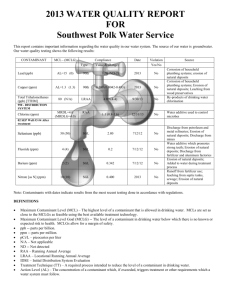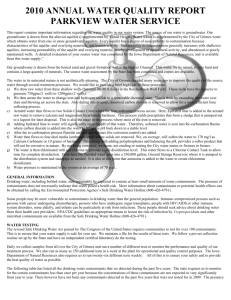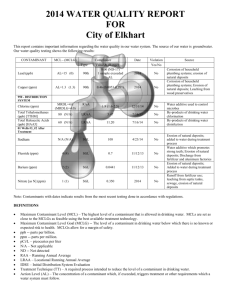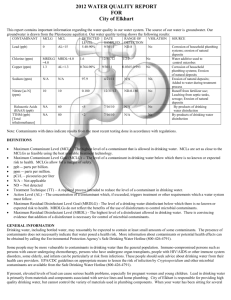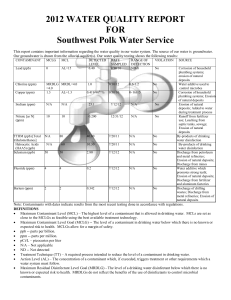Consumer Confidence Report 2014
advertisement
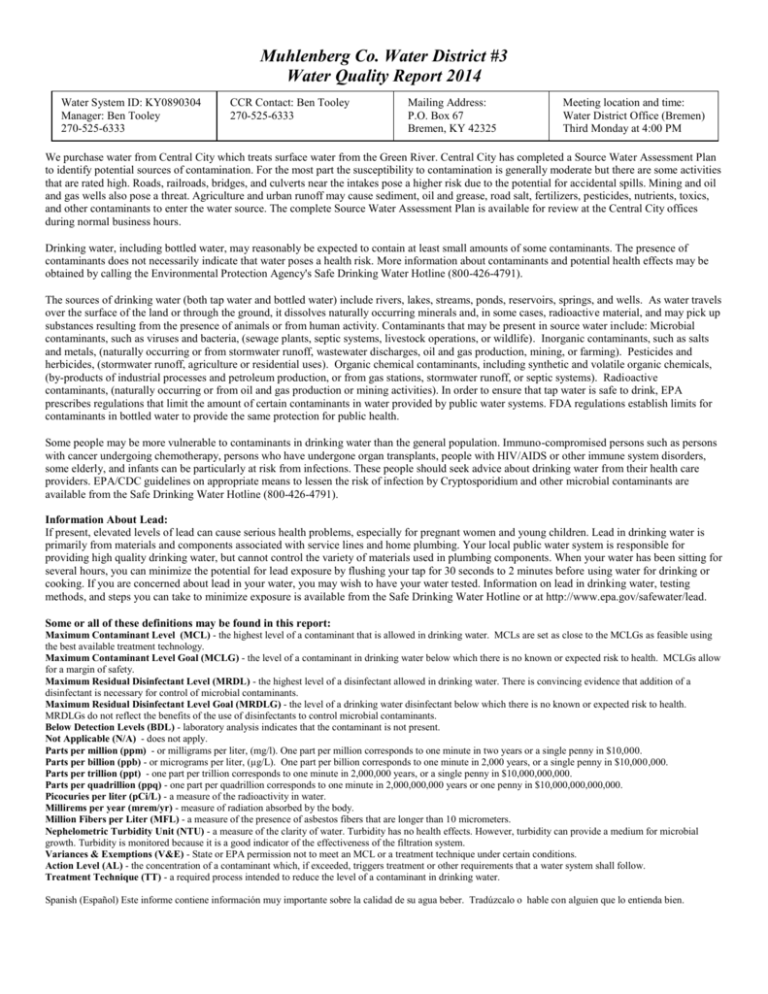
Muhlenberg Co. Water District #3 Water Quality Report 2014 Water System ID: KY0890304 Manager: Ben Tooley 270-525-6333 CCR Contact: Ben Tooley 270-525-6333 Mailing Address: P.O. Box 67 Bremen, KY 42325 Meeting location and time: Water District Office (Bremen) Third Monday at 4:00 PM We purchase water from Central City which treats surface water from the Green River. Central City has completed a Source Water Assessment Plan to identify potential sources of contamination. For the most part the susceptibility to contamination is generally moderate but there are some activities that are rated high. Roads, railroads, bridges, and culverts near the intakes pose a higher risk due to the potential for accidental spills. Mining and oil and gas wells also pose a threat. Agriculture and urban runoff may cause sediment, oil and grease, road salt, fertilizers, pesticides, nutrients, toxics, and other contaminants to enter the water source. The complete Source Water Assessment Plan is available for review at the Central City offices during normal business hours. Drinking water, including bottled water, may reasonably be expected to contain at least small amounts of some contaminants. The presence of contaminants does not necessarily indicate that water poses a health risk. More information about contaminants and potential health effects may be obtained by calling the Environmental Protection Agency's Safe Drinking Water Hotline (800-426-4791). The sources of drinking water (both tap water and bottled water) include rivers, lakes, streams, ponds, reservoirs, springs, and wells. As water travels over the surface of the land or through the ground, it dissolves naturally occurring minerals and, in some cases, radioactive material, and may pick up substances resulting from the presence of animals or from human activity. Contaminants that may be present in source water include: Microbial contaminants, such as viruses and bacteria, (sewage plants, septic systems, livestock operations, or wildlife). Inorganic contaminants, such as salts and metals, (naturally occurring or from stormwater runoff, wastewater discharges, oil and gas production, mining, or farming). Pesticides and herbicides, (stormwater runoff, agriculture or residential uses). Organic chemical contaminants, including synthetic and volatile organic chemicals, (by-products of industrial processes and petroleum production, or from gas stations, stormwater runoff, or septic systems). Radioactive contaminants, (naturally occurring or from oil and gas production or mining activities). In order to ensure that tap water is safe to drink, EPA prescribes regulations that limit the amount of certain contaminants in water provided by public water systems. FDA regulations establish limits for contaminants in bottled water to provide the same protection for public health. Some people may be more vulnerable to contaminants in drinking water than the general population. Immuno-compromised persons such as persons with cancer undergoing chemotherapy, persons who have undergone organ transplants, people with HIV/AIDS or other immune system disorders, some elderly, and infants can be particularly at risk from infections. These people should seek advice about drinking water from their health care providers. EPA/CDC guidelines on appropriate means to lessen the risk of infection by Cryptosporidium and other microbial contaminants are available from the Safe Drinking Water Hotline (800-426-4791). Information About Lead: If present, elevated levels of lead can cause serious health problems, especially for pregnant women and young children. Lead in drinking water is primarily from materials and components associated with service lines and home plumbing. Your local public water system is responsible for providing high quality drinking water, but cannot control the variety of materials used in plumbing components. When your water has been sitting for several hours, you can minimize the potential for lead exposure by flushing your tap for 30 seconds to 2 minutes before using water for drinking or cooking. If you are concerned about lead in your water, you may wish to have your water tested. Information on lead in drinking water, testing methods, and steps you can take to minimize exposure is available from the Safe Drinking Water Hotline or at http://www.epa.gov/safewater/lead. Some or all of these definitions may be found in this report: Maximum Contaminant Level (MCL) - the highest level of a contaminant that is allowed in drinking water. MCLs are set as close to the MCLGs as feasible using the best available treatment technology. Maximum Contaminant Level Goal (MCLG) - the level of a contaminant in drinking water below which there is no known or expected risk to health. MCLGs allow for a margin of safety. Maximum Residual Disinfectant Level (MRDL) - the highest level of a disinfectant allowed in drinking water. There is convincing evidence that addition of a disinfectant is necessary for control of microbial contaminants. Maximum Residual Disinfectant Level Goal (MRDLG) - the level of a drinking water disinfectant below which there is no known or expected risk to health. MRDLGs do not reflect the benefits of the use of disinfectants to control microbial contaminants. Below Detection Levels (BDL) - laboratory analysis indicates that the contaminant is not present. Not Applicable (N/A) - does not apply. Parts per million (ppm) - or milligrams per liter, (mg/l). One part per million corresponds to one minute in two years or a single penny in $10,000. Parts per billion (ppb) - or micrograms per liter, (µg/L). One part per billion corresponds to one minute in 2,000 years, or a single penny in $10,000,000. Parts per trillion (ppt) - one part per trillion corresponds to one minute in 2,000,000 years, or a single penny in $10,000,000,000. Parts per quadrillion (ppq) - one part per quadrillion corresponds to one minute in 2,000,000,000 years or one penny in $10,000,000,000,000. Picocuries per liter (pCi/L) - a measure of the radioactivity in water. Millirems per year (mrem/yr) - measure of radiation absorbed by the body. Million Fibers per Liter (MFL) - a measure of the presence of asbestos fibers that are longer than 10 micrometers. Nephelometric Turbidity Unit (NTU) - a measure of the clarity of water. Turbidity has no health effects. However, turbidity can provide a medium for microbial growth. Turbidity is monitored because it is a good indicator of the effectiveness of the filtration system. Variances & Exemptions (V&E) - State or EPA permission not to meet an MCL or a treatment technique under certain conditions. Action Level (AL) - the concentration of a contaminant which, if exceeded, triggers treatment or other requirements that a water system shall follow. Treatment Technique (TT) - a required process intended to reduce the level of a contaminant in drinking water. Spanish (Español) Este informe contiene información muy importante sobre la calidad de su agua beber. Tradúzcalo o hable con alguien que lo entienda bien. T he data presented in this report are from the most recent testing done in accordance with administrative regulations in 401 KAR Chapter 8. As authorized and approved by EPA, the State has reduced monitoring requirements for certain contaminants to less often than once per year because the concentrations of these contaminants are not expected to vary significantly from year to year. Some of the data in this table, though representative, may be more than one year old. Turbidit y (NT U) T T Al l owabl e Highe st Single Le ve ls Me asure me nt Viol ati on Like ly Source No more than 1 NT U* * Representative samples Less than 0.3 NT U in of filtered water Lowe st Monthly % 0.094 100 No Soil runoff 95% of monthly samples Re gulate d Contaminant Te st Re sults (Coppe r, Le ad, Chlorine, HAA, TTHM by Muhle nbe rg #3. All othe rs by Ce ntral City) C on tami n an t [code ] (units) MC L MC LG Re port Ran ge Date of Le vel of De te ction S ampl e Vi ol ati on Like ly Source of C on tami n ati on Barium [1010] (ppm) Copper [1022] (ppm) 2 2 AL = sites exceeding action leve 1.3 0.028 to 0.028 2014 No Drilling wastes; metal refineries; erosion of natural deposits 0.0015 t o 0.0222 2012 No Corrosion of household plumbing systems 0.028 0.018 1.3 0 (90 th percent ile) Fluoride [1025] (ppm) Lead [1030] (ppb) 4 4 1.1 0 (90 th AL = sites exceeding action leve 15 0 #DIV/0! 1.1 to 1.1 2014 No Water additive which promotes strong teeth 0 to 0.541 2012 No Corrosion of household plumbing systems 0 percent ile) Nit rat e [1040] (ppm) 10 10 1.7 1.7 to 1.7 2014 No Fertilizer runoff; leaching from septic tanks, sewage; erosion of natural deposits 50 50 3.4 3.4 to 3.4 2014 No Discharge from petroleum and metal refineries or mines; erosion of natural deposits 3 3 0.2 BDL to 0.4 2014 No TT* N/A (lowest 1.21 to 2.56 2014 No Selenium [1045] (ppb) At razine [2050] (ppb) T otal Organic Carbon (ppm) (measured as ppm, but 1.57 reported as a ratio) average) Runoff from herbicide used on row crops Naturally present in environment . (monthly ratios) *Monthly ratio is the % T OC removal achieved to the % T OC removal required. Annual average must be 1.00 or greater for compliance. Chlorine (ppm) MRDL MRDLG 1.42 =4 =4 (highest 0.60 to 2.12 2014 No Water additive used to control microbes. 16.6 to 38.6 2014 No Byproduct of drinking water disinfect ion 2014 No Byproduct of drinking water disinfect ion. average) HAA (ppb) (Stage 2) [Haloacetic acids] 29 60 N/A (high site average) (range of individual sites) T T HM (ppb) (Stage 2) [total trihalomethanes] 46 80 N/A (high site 12 to 87 average) (range of individual sites) Fl uori de (adde d for de ntal he al th ) Average 0.99 Ran ge of De te cti on 0.69 to 1.27 Violations Violations 2014-213 & 2014-214 We are required to collect samples and test for chlorine every day and report those results on a Monthly Operation Report (MOR). We collected the chlorine samples but failed to send Division of Water our MOR for January 2014 and received a monitoring violation. Since the chlorine results were included in the MOR a second violation was issued for failing to report chlorine results. We have submitted the documents and a public notice was sent to all customers. 2014-593 We received a monitoring violation when our contract lab failed to submit required information to Division of Water for disinfection by-product samples collected during the first quarter of 2014. A public notification was sent to customers for that violation and procedures established to prevent future events. Violations 2015-219 & 2015-220 Our water system failed to comply with a required testing procedure. Even though this was not an emergency, as our customers, you have a right to know what happened and what we did to correct the situation. *We are required to monitor your drinking water for specific contaminants on a regular basis. Results of regular monitoring are an indicator of whether or not our drinking water meets health standards. During November 2014, we did not complete all monitoring or testing for chlorine, and therefore cannot be sure of the quality of your drinking water during that time.* There is nothing you need to do at this time. You may continue to drink the water. If a situation arises where the water is no longer safe to drink, you will be notified within 24 hours. We are required to collect samples and test for chlorine every day and report those results on a Monthly Operation Report (MOR). We collected the chlorine samples but failed to send Division of Water our MOR for November 2014 and received a monitoring violation. Since the chlorine results were included in the MOR a second violation was issued for failing to report chlorine results. We have submitted the documents and have implemented procedures to hopefully prevent similar violations in the future. For more information, please contact Ben Tooley at 270-525-6333 or P.O. Box 67 Bremen, KY 42325. *Please share this information with all the other people who drink this water, especially those who may not have received this notice directly (for example, people in apartments, nursing homes, schools, and businesses). You can do this by posting this notice in a public place or distributing copies by hand or mail.* This report will not be mailed unless requested. Please call our office if you have any questions.


